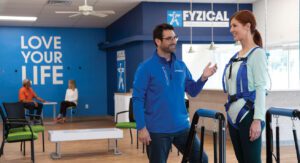By Dr. Chris Mulvey, PT
 Nearly 36 million seniors fall each year.
Nearly 36 million seniors fall each year.
Millions more won’t even tell their doctor or family members. They may be afraid to admit they’re vulnerable. They may not want their children or spouse to worry. They may be concerned about the cost of medical treatment.
It’s time to talk about it.
Sept. 21-25 is Falls Prevention Awareness Week, an educational initiative of the National Council on Aging. Falls are the leading cause of both fatal injury and nonfatal trauma-related hospital admissions among older adults. Beyond physical injuries, falls also can lead to overwhelming fears of falling, loss of independence and social isolation.
While it’s commonplace for women to have annual mammograms beginning at age 45 and men to schedule prostate exams starting at age 50, few seniors schedule fall-risk assessments as part of their preventative health care practices. Our parents and grandparents seem to accept that falls are a fact of life as we age, but many falls can be prevented.
FYZICAL Therapy & Balance Centers aims to help seniors and their caregivers learn about risk factors and how to prevent falls through its annual “Fight the Fall” campaign. During Falls Prevention Awareness Week, FYZICAL will provide complimentary fall-risk screenings to identify the unique strengths and functional limitations that make an individual more susceptible to falls.
Many in the medical community are particularly concerned this year as seniors quarantine at home to protect themselves against COVID-19. Physical activity stimulates muscle strength and flexibility, two key factors in preventing falls.
A fall-risk screening has three components:
• Pre-exam: Patient history often indicates potential complications. Chronic conditions like arthritis and Parkinson’s weaken the body, and thus increase the likelihood of a fall. Poor vision, orthopedic conditions and neurological disorders also can be contributing factors. An examination of prescription labels can also help identify potential side effects like dizziness, headaches, nausea and sleepiness.
• Physical exam: A physical therapist will evaluate a patient’s gait, or walking skills, to determine potential problems. Poor posture and weak hips, ankles and muscles also can lead to balance problems.
• Post-exam: After identifying potential compromises in balance, flexibility and strength, physical therapists can develop an individualized program for core and lower extremity strength, balance, endurance and flexibility.
Seniors face an overall decline in physical fitness, but that doesn’t necessarily mean they are more likely to fall.
Beyond health, the home environment also plays a role in senior falls. Floors, hallways and stairs should be kept free of clutter, and outdoor walkways should be well-lit and not have potential trip hazards like cracks in concrete or exposed tree roots. Showers and bathtubs should have grab bars, and staircases should have handrails on both sides. Eliminate potential trip hazards like throw rugs and appliance cords.
Footwear also presents a fall hazard. Shoes should have slip-resistant soles and adequate heel support.
In addition to seeing a physical therapist, annual visits to an optometrist and otolaryngologist are critically important to balance. Your eyes and ears are two very important keys to stability as you age.
To schedule a complimentary fall-risk assessment, please visit FYZICAL.com to find the nearest location.
About the Author
Dr. Chris Mulvey, PT, is president for company clinics at FYZICAL Therapy & Balance Centers, which has 405 locations in 45 states. For more information, please visit Fyzical.com.








